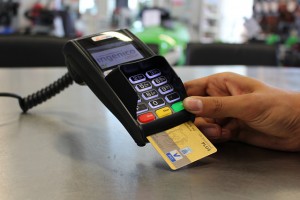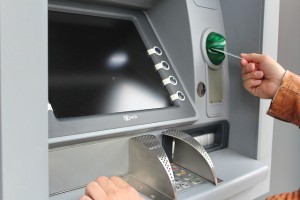Before Debit Cards

Before the 21st century, if you wanted to buy groceries or visit the mall, you had 4 options that you could use to pay, all of which had their own drawbacks: Cash, checks, credit cards, and short-term financing.
Cash is always reliable to make a purchase, but is prone to being lost or stolen. Not all shops accept checks, both because they are inconvenient to cash, and because of the ease of check fraud (writing a check for which you do not actually have the bank deposits to pay). Credit and short-term financing both include financing charges, so using these methods usually made purchases more expensive.
Between cash and checks, most people carried an ATM card, which could be used at ATM machines to withdraw cash and check bank balances on the go. Since most people already had these cards, many convenience stores installed ATM machines right near their cash registers, so customers could withdraw cash directly ahead of making a purchase. This meant many stores could eliminate the need to accept checks or credit cards (which also include transaction fees to the businesses for each purchase), and just have all customers use cash, without requiring them to carry it all day.
The Birth of Debit
This system began in the 1970’s, when the first ATM machines were invented, and still continues today in some older convenience stores that have not adopted their own card readers. However, in the 1980’s and 1990’s, some bigger grocery stores and other chains began integrating the ATM system directly in to their checkout system. This allowed “ATM” purchases – allowing customers to make payments directly from their bank account, without relying on paper checks. This system is called “online debit”, since every time you make a payment, the debit card reader validates the purchase immediately against your bank balance and executes the transaction.
This system was popular (and is still in place today), but there was one piece missing – stores around the world already accepted credit cards, and the process of integrating ATMs with the checkout system was costly. To get around this last hurdle, banks that issued ATM cards began working directly with credit card issuers to build the modern Debit Card – an ATM card that can also process payments anywhere credit cards are accepted. This type of payment, called “offline debit”, works differently – instead of validating the transaction immediately, transactions are validated in batches by the credit card companies (usually within 1-2 days).
Online and Offline Debit

Online debit works almost instantly – if you have a mobile app for your checking account, you will probably see the funds get deducted from your account a few minutes after a purchase has completed. Offline debit does not work quite as fast. Instead of immediately deducting the funds, the credit card processor usually puts a “hold” on your account for the purchase amount, then actually deducts the payment a few days later.
Because of this delay, you should still always keep a record of all your debit purchases – otherwise you could accidentally overdraw based on just a quick check of your bank balance.
Sometimes you will have the option to pick which transaction you want – if a card reader asks “Debit or Credit” for your card, the “Debit” transaction is typically online, while the “Credit” option is typically offline.
Debit Limits and Fees
Debit cards work similarly to credit cards when you want to buy something, but the fees work very differently. Credit cards make their money by charging interest on borrowed amounts, they usually do not charge customers for each transaction (or limit the number of transactions you can make).
Debit cards use your already existing bank balances, so you won’t get interest charges, but banks do still charge to use them.
Typical debit cards issued to young people might have a few different kinds of charges:
- Account Fees – this would be a fee charged for having your checking account. This fee will usually go up or down depending on your checking account type – account types that give you more flexibility with your debit card are usually more expensive
- Usage Limits – your bank may limit the number of times you can use your debit card per month (which can be as low as 10 transactions). If you go over this limit, you will typically be charged a fee per transaction.
- Overdraft fees – Overdraft fees happen when you spend more on your debit card than you had in your checking account. Your checking account may or may not allow overdraft – you can choose to opt in or opt out. If your account does not allow overdraft and you attempt to make an “online debit” transaction, the transaction will be declined.
Pop Quiz
[qsm quiz=86]
Challenge Questions
- How is a debit card and credit card different?
- How might using a credit card at an ATM be different than using a Debit card?
- How do you know if some ATM machines charge for their services.
- List 5 places where an ATM is located near to where you live.
